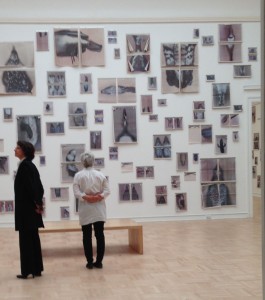
Ann Hamilton and curator, walking through her installation for the first time at the Henry Art Gallery in Seattle. All images courtesy CHE. (click images to enlarge)
A Review of The Henry Art Gallery Installation
In true Ann Hamilton form the exhibit at University of Washington’s Henry Art Gallery in Seattle is a constellation of words and pictures coupled with formal and intimate exchanges that attract and repel depending on what you bring to the work. It is a careful, multi-layered presentation of the physical place, her specific vision and your participation. Collectively the seemingly soft touch of each artistic choice and chosen object packs a cumulative wallop – an urgent wake up to burning questions that need fast attention. In the artist’s words this project was an act of care, a collaboration with the institutions, the community and a gift exchange. While this is her second major installation at the Henry Art Gallery, the two moments could not be more different. In 1992 she had 200 free-flying canaries throughout the then smaller facility, now there are only dead animals, and a highly directed experience in a much larger space.
Any good artistic inquiry always begins with the right questions. For “the common SENSE” Ann Hamilton engaged with the following questions:
- How do you keep things open and available to all people?
- How do we live with the knowledge of extinction?
- What are the conditions that make “we” possible?
- How to approach an exhibit in an art museum ensconced in a research organization?
When you enter the exhibit a greeter explains what you may choose to experience, how to navigate and what your options are. There is a photo booth set up where you may come back at the end of your walk through to take a picture of yourself for the archive of the project. There is a shelf of books (Death in Spring, a dark, surreal tale by Catalan author Merce Rodoreda), pencils, notebooks, bells, blankets, boards and folders. The book is meant to be read to the objects in the exhibition, and the notebooks are meant for you to share your reflections. Underneath the shelf are soft ivory blankets and wood boards for leaning on to write. Each emblazoned with an exhibition marker/logo. The folders are for collecting the readings throughout the exhibition that are stacked in neat piles throughout the different rooms. I’m guessing the bells are to make noises to interrupt or mark the beginning or end of your reading in the galleries.
Without yet entering the exhibition you are now either a. intimidated and exhausted at the prospects of the intellectual choosing and filing you need to do, or b. thrilled and curious about how you can participate in this living and breathing exhibit, knowing your choices have a consequence.
The front room begins with the reading piles. These have been collected by Ann and her collaborators on a web site. This web site is live, and you may contribute to the collection as well. All readings collected must carry “the register or description of touch: between animal and human, between hand and cloth, between word and material, between body and environment”. You begin, however fast or slow you read, to pick and choose that which you are attracted to. I didn’t count, but there seems to be over 200 stacks of printout piles throughout the exhibit.
This practice of collecting writings is actually a thing – it’s called “commonplacing”. A commonplace book is a model for organizing knowledge. The idea is that the things you choose are a reflection of you – they mirror you. That said, all of these writings in the exhibit mirror Ann and that which she puts her attention on as an artist – animal and human relations, sense of touch in all of it’s manifestations, and reading/books.
I was able to attend the walkabout where Ann was there to see the exhibit in situ for the first time, and spoke to a small group about the origins and manifestation of the exhibition. On no uncertain terms the exhibit she explained was a focus on the act of reading.
“Reading is like drawing. How one reads is one’s studio.” – Ann Hamilton, 2010 at her National Gallery of Art talk
She spoke about how you are changed by the landscape of what and how we read. Clearly from the selection of books, visuals and objects she was hoping to change our perceptions and reconsider the fate of animals. Whether you stumbled on the literary description of geese and chickens, or a dog dying you left the exhibit with a palatable shift in perspective on how we share this earth with animals.
If you are not moved by the written word, then the three enormous rooms covered in newsprint of dead animal images could move you to consideration. As with most of Ann’s gestures this was multilayered. Reading was not abandoned in these rooms as they are printed on newsprint. Each animal was placed on a flatbed scanner and captured with an emphasis on what touched the glass of the scanner – a reference to touch. There was sound in these galleries which she explained was an alarm. I believe the sound was much cozier than an alarm: when it went off it sounded like a tea kettle which to me marks the sign of a cozy chat or a good read. Like the “gift” of the printed readings offered for taking, you are invited to participate in two ways here – you may take any of the newsprints home with you, and you may choose to sit and read to the newsprint images on the wall. When I entered the back gallery there was a woman reading from the chosen book to a scanned image of a dead duck’s feet.
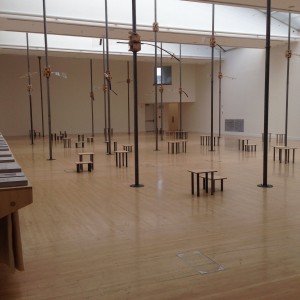
Very loud sound piece, featuring the table-like chairs for resting. Tables feature prominently in almost all of Ann Hamilton’s major works, this installation is no exception.
Next you stroll down to the final floor of the exhibition with two parts. There is an enormous room that has more reading material, and a very loud sound piece which drowns any sound whatsoever. There were stools throughout this large space, inviting you to rest and take in the noise. At this point in the exhibition I found the space a welcome palate cleanse. I likened the tall poles with what looked like whirling makeshift oars to windmills, and was literally imagining my mind being swept with a broom with all of the flying detritus of information. A settling space for all the difficult visuals and text I had consumed.
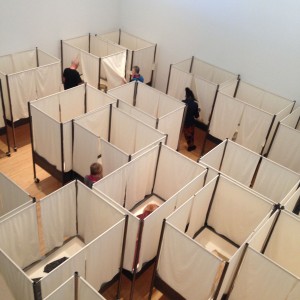
Aerial view of bassinets carrying various clothes created using animal pelt. The pieces were lent by the Adjacent Burke Museum of Natural History and Culture.
The last spot was the “bassinets” as she called them. They were individual display cases of clothing made from animal skin, covered in glass. While you could not touch the specimens, the metal cases were covered with white cloth that you needed to touch in order to see them. There were also carefully hand written labels hanging from the top of the display. The metal display on wheels with the hanging tags felt very much like a morgue, where the tags would have read “DOA” versus “Mink Coat from the 1950s”. In general the display was very uncomfortable as they were cramped in an unclear cluster. I believe this was by design, as it’s perhaps troubling for the artist to see these gifts from the animals whereas people have mostly seen them as clothes.
Upon exiting the exhibition, the greeter asked me if I wanted to take a picture. I agreed, filled out my consent form, then stood behind an opaque, thick plastic sheet. The sheet was reminiscent of the scanner photos of the dead animals, and the greeter, now taking my picture, asked me to touch the sheet so she could take the picture. With my cheek and hand touching the sheet I was entirely comfortable knowing she couldn’t see me fully, and entirely uncomfortable feeling like an animal specimen being scanned on a scanner bed. I suppose that was my gift to the artist – a completely unconscious and ambiguous slice of myself for the project’s record.
Ann Hamilton: the common SENSE
October 11, 2014 — April 26, 2015
Henry Art Gallery
University of Washington
15th Ave NE and NE 41st St
Seattle, WA 98195
+1 (206) 543 2280
info@henryart.org
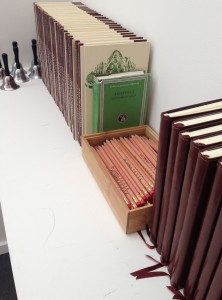
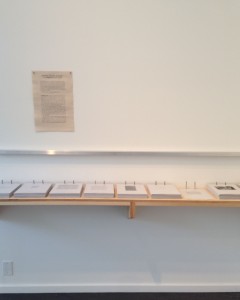
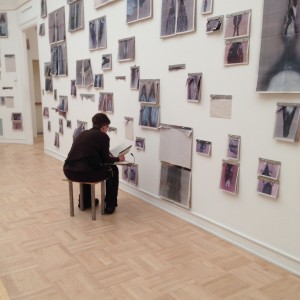
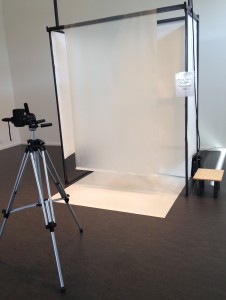
0 Comments
Would you like to share your thoughts?